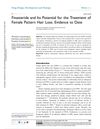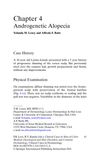How come topical finasteride even works at all? Finasteride/Dutasteride 11/9/2025
Topical finasteride can effectively reduce scalp DHT by targeting local enzymes, despite less systemic impact compared to oral forms. Combining oral dutasteride with topical finasteride and minoxidil may enhance hair loss prevention, though evidence of its effectiveness is limited.
View this post in the Community →
Similar Community Posts Join
6 / 1000+ resultscommunity New topical Dutasteride from Moogene will have 20 times better scalp absorption than oral Dutasteride. And much lower system absorption.
A new topical Dutasteride with 20 times better scalp absorption being developed and tested for release in 2023; use of existing drugs, such as Minoxidil and finasteride; and mesotherapy as an alternative hair loss treatment.
community What's the efficacy of oral vs topical fin or min or dut? Can I just do one or the other, of is it better to combine?
The conversation is about comparing the effectiveness of oral versus topical treatments for hair loss, specifically finasteride, minoxidil, and dutasteride. The user is currently using topical finasteride and minoxidil but is considering switching to oral dutasteride and minoxidil for convenience.
community Study shows further evidence that finasteride and dutasteride take 12-18 months or more to show significant results. Do NOT give up early
The conversation discusses the effectiveness of finasteride and dutasteride in treating hair loss, emphasizing that significant results often take 12-18 months or more. Dutasteride is generally considered superior, with similar or fewer side effects than finasteride, but patience is required for noticeable improvement.
community Combining topical finasteride with oral finasteride
The conversation discusses combining topical and oral finasteride to address hair thinning, with concerns about safety and effectiveness. Users also mention alternatives like dutasteride and minoxidil, and the potential risks of topical treatments during pregnancy.
community Topical is superior to oral in terms of results (my theory)
The conversation discusses the use of topical minoxidil and finasteride for hair loss, with some users combining them with oral treatments. Users share their experiences and opinions on effectiveness, cost, and convenience, with mixed views on whether topical or oral applications are superior.
community Why you may be taking Dutasteride wrong
Dutasteride is more effective than finasteride for hair loss, with optimal dosing at 0.5mg once or twice a week to minimize side effects. Topical application may further reduce side effects while effectively lowering scalp DHT.
Related Research
6 / 1000+ results
research Androgenetic Alopecia: A Review and Emerging Treatments
Hair loss, known as Androgenetic Alopecia, is often caused by hormones and can be diagnosed using noninvasive techniques. Treatments include topical minoxidil and oral finasteride, with new treatments being explored. There may also be a link between this type of hair loss and heart disease risk.

research Antiandrogens and Androgen Inhibitors in Dermatologic Treatments
Antiandrogens and androgen inhibitors like spironolactone, finasteride, and dutasteride can treat hair loss and skin conditions, but they have risks and side effects, including potential harm to pregnant women and risks of cancer and heart issues. Herbal remedies also have antiandrogenic effects but lack safety validation.

research Finasteride and Its Potential for the Treatment of Female Pattern Hair Loss: Evidence to Date
Finasteride shows promise for female hair loss, but more research needed.

research Androgenetic Alopecia: A Review
Male pattern baldness involves genetics, hormones, and needs better treatments.

research Androgenetic Alopecia: Case Study and Treatment Options
Hair loss treated with minoxidil, finasteride, laser/light, hair transplant, and scalp prostheses; more research needed for skin of color.
research Female Pattern Hair Loss: An Update
Female pattern hair loss has multiple causes and treatments, with new therapies showing promise.